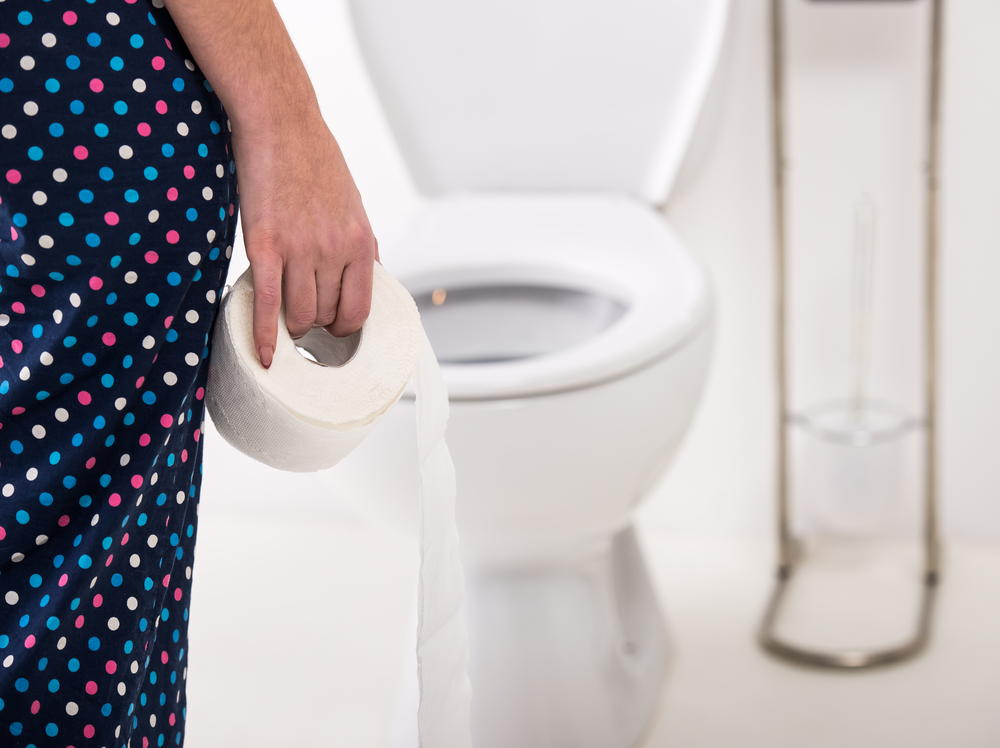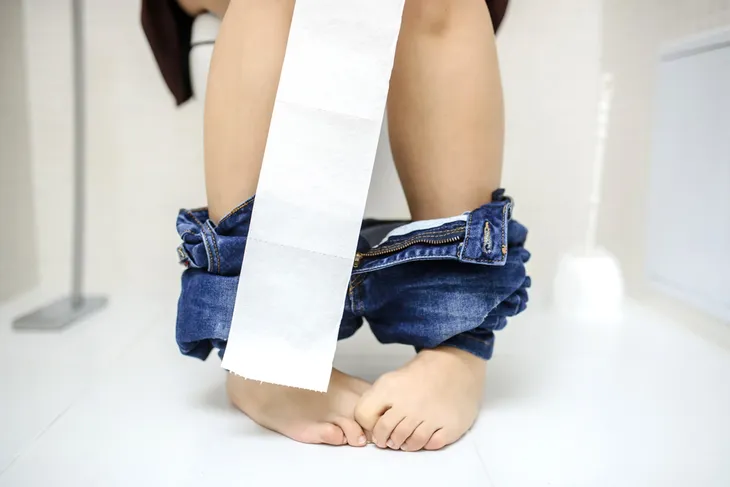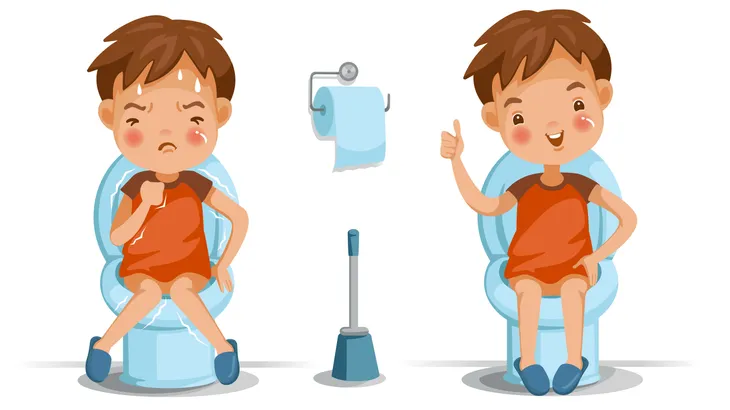Okay, we admit this isn’t the most pleasant topic, but what comes out of you can say a lot about your overall health. In fact, Prevention says that even against your instincts, you may want to give your poop a glance before you flush it down. “It’s actually one of the best clues you have to your health,” it explains.
That being said, these identifiers found in bowel movements can show you need to change your diet, or can point to possible health problems that warrant a closer inspection by your doctor. Here are 16 strange signs from your stool that there might by an underlying health problem…
1. None Shall Pass
Prevention.com says that if your poop appears hard in places or you really had to strain to get it out, you’re probably constipated. That’s probably obvious. But why? The primary reason is a lack of proper fiber intake, which should be 25-grams per day for women and 38-grams per day for men (most people only consume 15-grams a day, says the source).
An easy way to keep track is by reading labels or by keeping a food journal for a week to see how your fiber intake adds up. If you’re looking for quick sources of fiber, turn to fruits, whole grains, nuts, or seeds.
2. Black Flags
If you notice your stool is very dark or black and is “coffee ground-like in appearance,” it could be a sign of bleeding in the upper gastrointestinal tract, warns Healthline. “The blood is older and therefore travels down the intestinal tract,” it explains.
However, it’s not just blood that can turn your poop black. The source says that iron supplements, bismuth medications such as Pepto-Bismol (to treat upset stomach and heartburn), and even black licorice can have a similar effect.
3. Mellow Yellow
MedicineNet.com explains that “pale yellow” and greasy stool that’s foul-smelling (we don’t know of too many types that aren’t) can be a sign of poor absorption of fat due to a possible problem with your pancreas.
The site warns that this could be due to pancreatitis, pancreatic cancer, or cystic fibrosis. But don’t jump to any dire conclusions right away, as it might also be a sign of celiac disease, which is quite common and can be managed by cutting gluten from your diet.
4. Clay Formations
If your poop comes out looking like something that can be molded into a bowl and thrown into a kiln, then you may have problems with your biliary system, explains MedicinePlus.gov. This is the drainage system of the gallbladder, liver, and pancreas.
Bile is the substance that gives stool its characteristic brown color. However, if you have a liver infection, your bile production might be compromised, explains the source. The flow of bile may also be blocked. Jaundice (yellowing of the skin) often accompanies clay-colored stools, due to the buildup of bile in the system. If so, see your doctor.
5. Water Slides
If you’re experiencing diarrhea, then you know it can be unpleasant and can have you running to the bathroom in a hurry. The Huffington Post explains that this can be caused by mild food poisoning or consuming too many artificial sugars.
Other diarrhea triggers include certain food intolerances, adds the source. While it may seem counterintuitive, the source recommends consuming a lot of fluids if you have diarrhea (presumably to avoid becoming dehydrated), and even check with a dietician or doctor if it’s a regular problem.
6. Screen for Green
Green poop can be alarming, especially when it comes out of your toddler. However, the cause can be something as innocent as consuming artificial food coloring found in icing on a cupcake or birthday cake, explains MedicalNewsToday.com.
Other possible reasons for green poop include bile in the stool, indicating that food is moving too quickly through your intestine (such as in the case of having diarrhea). However, green stool can also point to parasites or bacteria including salmonella, Giardia, or norovirus. “These unwelcome guests can cause the guts to work faster than normal, impacting stool color,” adds the source.
7. Don’t (Always) Dread the Red
Well, not always. While red or maroon stool can be an indication of a condition called hematochezia (the professional way to say bloody stool), it can be from artificial food coloring, tomato juice/soup, or beets, explains VeryWell Health.
If it’s actually blood in the stool, still no reason to panic right away. It could be caused by hemorrhoids or anal fissures (a tear in the lining of the anal canal), notes the source. It could also be inflammatory bowel disease or diverticulitis. A medical professional will have to use tests to determine the exact source of the bleeding to reach a proper diagnosis.
8. Frequency
Most people probably don’t really take note of how often they are going to the washroom or the time of day. Healthline points out that most people actually go to the washroom around the same time every day. This is likely due to the fact that their eating schedule and diet tends to stay relatively similar from day to day.
On average, a healthy person can pass a stool anywhere from once every other day to three times a day. If you’re visiting the bathroom less than this then you are likely suffering from constipation. You should try drinking more water to help move things along.
9. Bristol Stool Scale
Everytime we pass a stool, it falls somewhere on the Bristol stool scale in terms of look and shape. This scale was designed to tell people what their stool shape says about their health. Healthline explains that it was created back in 1992 after a 2000 person study and is the best and easiest way to understand what our stool can tell us about our health.
Type 1 is defined as small, hard lumps that look like nuts. These are often hard to pass and mean you’re constipated. This type of stool should not be a regular occurrence. Type 2 is defined as “log shaped and lumpy,” says Healthline. It also means the person is constipated and shouldn’t happen on a regular basis.
Type 3 is again log shaped and lumpy, but this kind of stool has some cracks on the surface. According to Healthline, this is the “gold standard of poop, especially if it’s somewhat soft and easy to pass.” Type 4 is long and skinny like a snake. This is considered to be a normal stool and should occur every one to three days.
The next one is type 5 which is small, soft, and easy to pass. Healthline writes that the “blobs also have clear cut edges.” While it’s not necessarily considered diarrhea, this stool is too soft. It means you’re not eating enough fiber. You should consider adding more cereal and vegetables to your diet.
We’re now getting into the unhealthy stools again. Type 6 is described as “fluffy and mushy with ragged edges,” by the source. It’s too soft to be considered healthy, but is only a mild form of diarrhea. If you notice this type of stool, you should try to drink more water and fruit juice. We’ve all experienced type 7 at some point or another. It’s definitely not healthy. If you have type 7, your stool is watery with no solids. It means the stool moved through the body quickly and didn’t even form into a healthy stool.
10. Does it Sink or Swim?
You might not have ever noticed whether it does one or the other, but each one has their own reasoning behind it. A stool that sinks quickly to the bottom most likely means you’re not consuming enough fluids or fiber. Stools that sink quickly are often very dark because they’ve spent more time in the intestine, says VeryWell Health.
A floating stool isn’t something to be too concerned about, if it happens once in a while. “Most commonly, floating stool happens when you have increased gas that mixes into the stool, causing it to float. It can be caused by anything from carbonated drinks, beans, and sugary foods to conditions like irritable bowel syndrome,” explains Very Well Health. If it happens quite frequently, it could be a sign of something more serious such as your body isn’t absorbing fat properly which is called steatorrhea. “This type of stool often has an odor, sticks to the side of the bowel, or is difficult to flush away,” notes the source.
11. Length of Time
It’s still a mystery to me how much time men spend sitting on the toilet! It’s not uncommon for people to be teased or feel insecure about how much time they spend in the bathroom, because people will know what they are doing. What we should really be concerned about it how long it’s taking to pass a stool!
According to Healthline, a healthy stool should be fairly easy to pass and should only take about a minute. It should be a relatively short process nothing to be embarrassed about. However, the source does note that it can take some people a little longer and that’s still nothing to be concerned about. Anything longer than 10 to 15 minutes is unhealthy, notes the source.
12. Abnormal Bowel Movements
The average person should be having a bowel movement once a day or once every two days, and they should be either a type 3 or 4 on the Bristol stool scale. If you’re going more frequently than that it could be the result of a digestive condition like irritable bowel syndrome (IBS), Crohn’s disease, or ulcerative colitis.
These conditions are most often diagnosed through stool health, but they do have other defining symptoms that accompany them. SELF provides the example of irritable bowel syndrome, which is often characterized by “bouts of diarrhea or constipation (or alternating between the two), as well as abdominal pain and excess gas.”
Crohn’s disease is a chronic illness that causes inflammation in the bowel. People who suffer from Crohn’s experience chronic diarrhea, in addition to weight loss, fever, and lower abdominal pain, says SELF. The last example of conditions that cause abnormal bowel movements is ulcerative colitis, another inflammatory condition. It’s similar to Crohn’s disease in that it’s “marked by inflammation that begins in the rectum and spreads to other segments of the colon.” People with ulcerative colitis will also experience chronic diarrhea, but the defining factor between the two is that this condition causes bloody diarrhea.
13. Lots of Wiping
If you find that you’re going through more toilet paper than usual due to a lot of wiping, it could be a sign of gastrointestinal bleeding, says Everyday Health. This is because it causes the stool to become sticky and gel-like. If this is the case, it is something to be concerned about. The source recommends seeking out a doctor as soon as possible.
If you’re someone who suffers from hemorrhoids, which are enlarged blood vessels in the rectal area, then this could also be the cause. They tend to make it a little harder to wipe and get the area clean after a bowel movement, says Everyday Health.
14. It’s Hurts To Go
Every heard the saying, “everybody poops!” It’s true! It’s a natural part of being human. What’s not natural is if it hurts. You shouldn’t be avoiding the bathroom or in pain when passing a bowel movement. If you’re straining on the toilet, it means your constipated. While this isn’t an immediate cause for concern, if it happens on a regular basis, it could lead to hemorrhoids or tears in the sphincter muscle, says Anish A. Sheth, MD, a gastroenterologist at the University Medical Center of Princeton, when talking to Everyday Health.
If you’re experiencing pain as a result of hemorrhoids, then do not fret, it’s actually a very common problem. Luckily, there are many over-the-counter remedies, such as ointments or acetaminophen suppositories, that can help relieve the symptoms and reduce any swelling or irritation. “You might also take a stool softener such as docusate sodium or polyethylene glycol, which makes stools easier to pass,” writes the source. You should also start making a conscious effort to exercise more and eat more fiber. (Check out this article on Effective Home Remedies to Help Relieve Constipation).
15. It’s Mucusy
We often don’t notice this, but mucus can always be found in the stool, says VeryWell Health. We just don’t notice it (as we shouldn’t) because it’s clear. “A thick, jelly-like substance, mucus lubricates your intestines (protecting them from stomach acid, bacteria, viruses, or fungi) and makes bowel movements slippery and easy to pass,” writes the source.
With that being said, if you do notice any mucus in your stool, it could be a cause for concern. The mucus shouldn’t be white or yellow. If it is, let your doctor know. It doesn’t necessarily mean there’s something serious going on, but it’s probably worth mentioning at your next doctor’s visit. VeryWell Health explains that it could be due to inflammation or irritation in the intestinal wall which is often a result of an underlying health issue.
16. It Smells Extra Bad
This might be too much information, although let’s face it, this whole article has been crossing the line of personal info! If you notice that you’re stool has a much more potent smell than usual, it’s probably because of a specific food. Everyday Health writes that stools natural odor comes from mercaptans, which are sulfur-containing compounds. Certain foods like Brussel sprouts, onions, and red wine increase the body’s production of these compounds, so eating them will inevitably cause a stink, says Dr. Sheth, who is a co-author of What’s Your Poo Telling You?
However, if the odor is extremely unusual, it could also be due to more serious things like gastrointestinal bleeding, problems digesting fat, or other health conditions. “Fat makes its way into the stool and causes a terrible aroma,” says Dr. Sheth when talking to Everyday Health. “People with pancreatic or liver problems can’t digest fat appropriately,” adds the source.



















